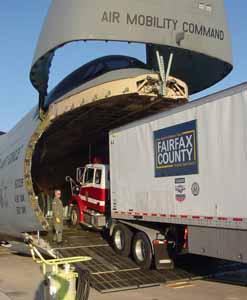


|
|
Mitch Gettle/U.S. Air Force via Getty Images
|
|
U.S. military cargo plane is loaded with supplies bound for town of Bam, Iran. This is first time the U.S. government has landed such aircraft on Iranian soil since Iran's 1979 popular revolution.
|
On December 29, seven U.S. military cargo planes carrying 50 tons of medical equipment and other supplies landed near Bam, the first time in 25 years that such aircraft have been allowed onto that country’s soil. Some 80 U.S. medical and other personnel have set up a field hospital. U.S. treasury secretary John Snow also announced the temporary easing of a 25-year ban on U.S. firms and individuals transferring funds to Iran, asserting that “getting aid to those so greatly affected by this devastating earthquake is a top priority” for the U.S. government. Washington broke off diplomatic relations with Iran in the months following the 1979 popular revolution that overthrew the U.S.-installed monarchy there.
“What we’re doing in Iran,” said U.S. president George Bush January 1, “is we’re showing the Iranian people the American people care, that we’ve got great compassion for human suffering.” He then listed Washington’s oft-repeated demands: “The Iranian government must listen to the voices of those who long for freedom, must turn over Al Qaeda that are in their custody, and must abandon their nuclear weapons program.”
The Japanese government said December 29 that it would send a pair of military aircraft to transport aid to the ruined city. The governments of France, Germany, and the United Kingdom have shipped search-and-rescue teams and food and medical supplies.
In October those three imperialist governments had arm-twisted Tehran into signing an agreement permitting surprise inspections of its nuclear power and research facilities. Iranian officials have repeatedly insisted that the country’s nuclear program is not for military purposes but for meeting electrical power needs.
In contrast, Cuban president Fidel Castro sent a message to Iranian president Mohammad Khatami saying that revolutionary Cuba “is ready to offer whatever assistance is needed to alleviate the suffering of the victims” with no strings attached, according to the Islamic Republic of Iran Broadcasting news agency.
In a December 29 Washington Post interview, U.S. secretary of state Colin Powell described as “encouraging” Tehran’s decision to give International Atomic Energy Agency officials the go-ahead to conduct surprise inspections, and its acceptance of the U.S. aid in Bam. Powell said, “We should keep open the possibility of dialogue at an appropriate point in the future.”
Post reporter Robin Wright commented, “U.S. officials have been encouraged by Iranian President Mohammad Khatami’s [recent] meetings with Jordan’s King Abdullah and Egyptian President Hosni Mubarak.” The governments of Jordan and Egypt remain the only two Middle Eastern regimes to have officially recognized the state of Israel.
Tehran rejects delegation
On January 2 the Iranian government rejected Washington’s proposal to send a “humanitarian” delegation headed by Sen. Elizabeth Dole and other U.S. officials to Iran. Tehran did not dismiss the offer outright, but said the time “is not ripe.”
“There should be something more substantial from the Bush administration, like taking back the ‘axis of evil’ title and waiving the senseless economic sanctions permanently, as well as returning Iran’s assets frozen” since 1979, said the Tehran daily Kayhan in an editorial.
One week after the quake reduced much of Bam to dust, 30,000 bodies have been dug out of its ruins. Many have been reburied in mass graves dug out by bulldozers. Government officials say the death toll could reach as high as 50,000 in a city that formerly housed nearly 100,000 people. Around 90 percent of Bam’s buildings—many of which were constructed using mud bricks—have been destroyed.
“The houses had steel in them but they were not designed to withstand earthquakes,” said Maheri Alizadeh, 52. “Why shouldn’t the government make sure that these houses are built properly in a country like here, where earthquakes are so frequent?” A 1990 earthquake that hit northwestern Iran took 50,000 lives.
“The earthquake reduced most of the buildings to something like talcum powder,” said Barry Sessions, a rescue worker from the United Kingdom. “There are few voids or gaps left in the buildings where we would normally find survivors.”
In a column published in the Christian Science Monitor under the title, “Iran’s quake: Nothing ‘natural’ about this disaster,” London writer Brendan O’Neill commented, “Humanity has developed the technology and know-how to withstand the effects of many earthquakes.” He cited the much lower death toll following tremors of equal or greater power in Japan and the United States.
At times like this, O’Neill said, “I find myself increasingly uncomfortable with the phrase ‘natural disaster.’” What the “developing world” needs, he wrote, is “to develop—and fast.” He did not explain, however, how that is possible in a world where the imperialist powers have prevented semicolonial nations from developing and robbed them of their resources.
Related articles:
U.S. blackmail of Iran
Front page (for this issue) |
Home |
Text-version home